21 November 2018
Brittle overprinting ductile in the South Mountains metamorphic core complex, Phoenix, Arizona
Posted by Callan Bentley
A few days ago, I showed you some flow banding in pseudotachylyte near Dobbins Lookout in the South Mountains, south of Phoenix, Arizona. I’d like to return to the South Mountains today for a more comprehensive look at the rocks exposed there. The South Mountains offer a geometrically-relatively-simple example of a metamorphic core complex.
Photo-wise, let’s start with this outcrop, which offers a good starting point for thinking about metamorphic core complexes.
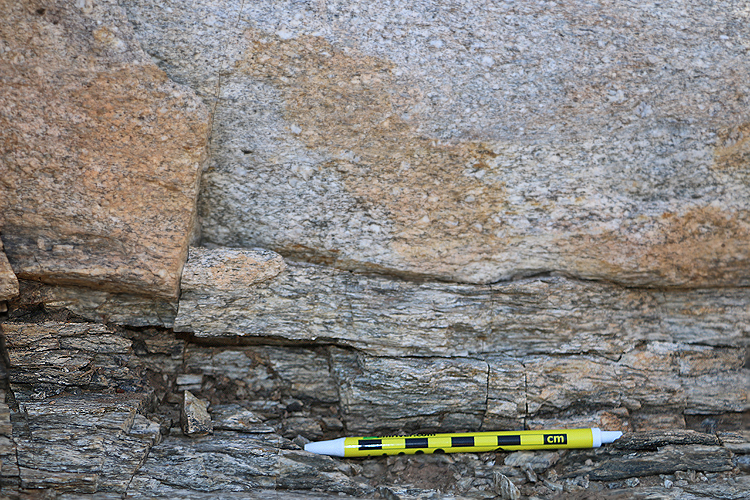
There you see a granite, and a deformed granite. Granite is an igneous rock: one of those rocks that forms from the slow crystallization of magma, deep underground. The undeformed granite is equigranular, meaning its crystals are about the same size and the same shape in every direction. But as you work your way down through the photo, the rock takes on more foliation, and the size of the big chunky feldspar crystals is reduced dramatically. Quartz crystals are “ribboned” out into long wraithlike things. This is what a granite looks like when you smear it out. The exact boundary between the granite and the smeared-out version of the granite is impossible to put your finger on here – the deformation is progressively more and more pronounced from top to bottom in this photo. By the time we’re at the bottom, though, we’ve got a mylonite.
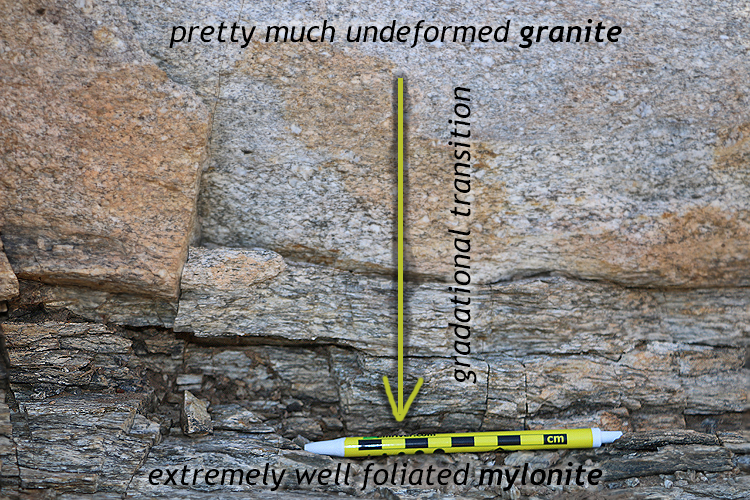
Mylonite is a structural rock term; it’s independent of the composition of the rock that got deformed. Mylonites can form from igneous rocks (as here) or from sedimentary rocks, or from metamorphic rocks. If they can smear out, they can hope to someday be lucky enough to be transformed into mylonite!

Mylonites were first described at Loch Eriboll in Scotland’s Northwest Highlands, where Charles Lapworth gave them their name and interpreted their fine grain size and foliation to be the result of thrust faulting. Rather than faults being crisp breaks in the crust, sometimes they could be broader zones of smeared-out rocks that accomodated the relative movement between two big blocks of rock in a diffuse zone of deformation. Lapworth’s insights helped solve the mystery of the Northwest Highlands (how Moine schist ended up on top of a Cambrian sedimentary sequence), and it gave the world a new way of looking at faulting – not only in terms of orientation (bedding-parallel) but also in terms of diffusivity.
In the South Mountains, the massive phaneritic granite you find at lower levels transitions at Dobbins Lookout into something very fine indeed:
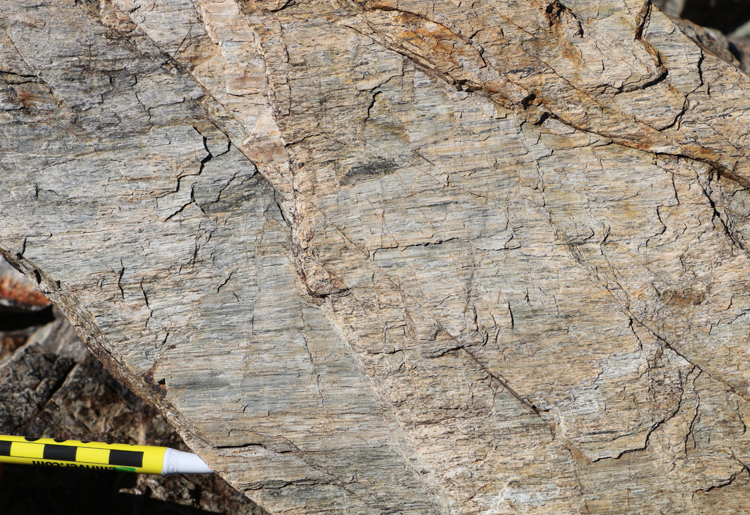
There are also darker varieties, that may have started off as some other lithology, but are just as smeared-out:
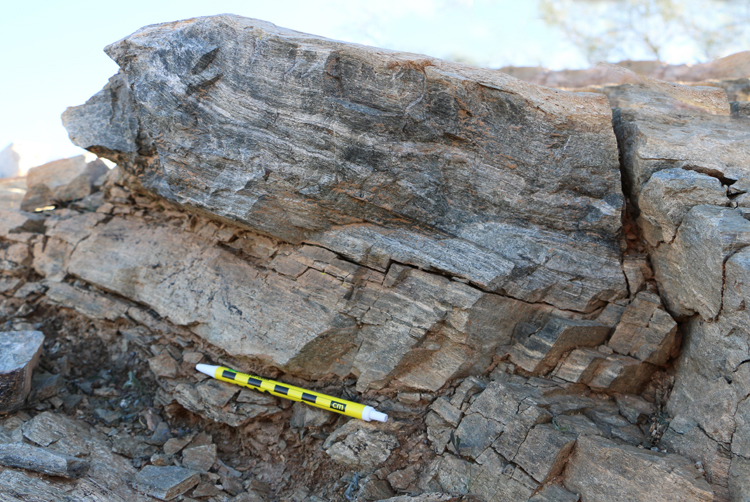

This little outcrop (of granitic-protolith mylonite) has a couple of tiny kinks running through it. These kink bands are like very crisp folds, and they only occur in rocks that have a strong mechanical layering, as here with the mylonitic foliation. Kinks are structures on the border zone between ductile and brittle, a taste of what’s to come…
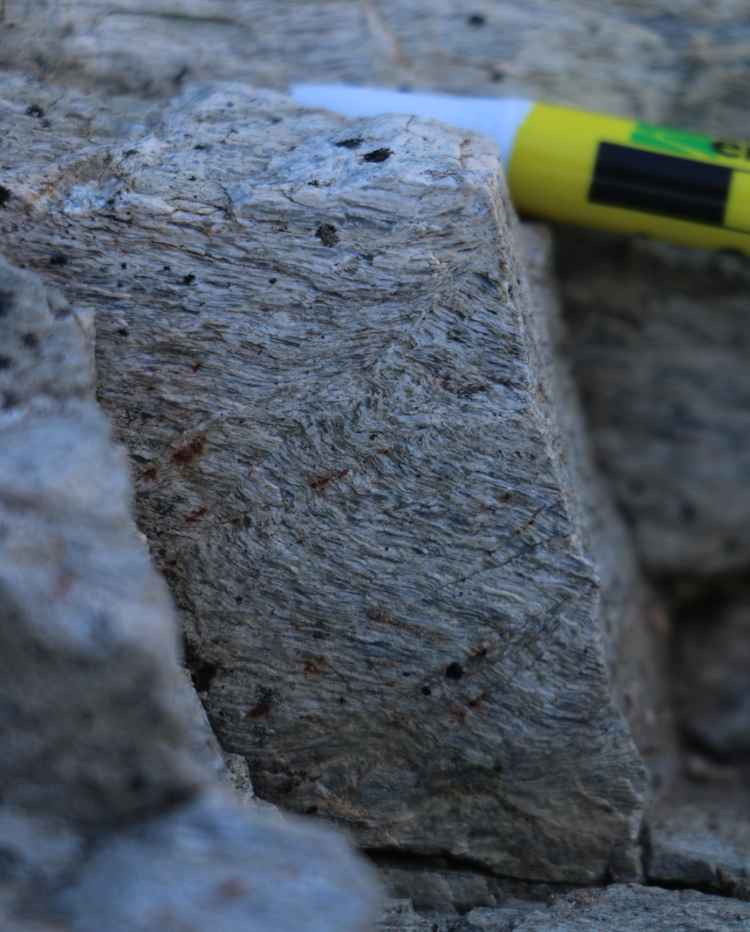
(There is also at least one proper microfault in that image. See if you can find it!)
It’s worth mentioning that mylonites are often lineated as well as foliated. While I’ve been showing you photos of the trace of the foliation surface so far, I can also aim the camera lens right down onto that foliation surface, and look at the lineations lying within it, like pencils aligned on the surface of a desk. These are mineral stretching lineations, and they point in the direction in which the rock was elongated. In the South Mountains, that’s an east-northeast/west-southwest orientation, and it’s the direction the hanging wall block slid off the top of the metamorphic core complex. In other words, it’s the direction of crustal extension.
Here’s a comparison between lineations, both coarse and fine:


There’s some serious grain size reduction between the first lineation photo and the second. That’s mylonitization for you! Grain sizes are dramatically reduced as the rock’s constituent minerals are “milled out” and smeared into wispy blebs.
Okay, now let’s zoom out and look at the overall geology of the mountain range, before diving back in to outcrop photos. Here is a geologic map of the South Mountains by Steve Reynolds and Julia Johnson of Arizona State University, shared with geologists attending the January 2018 Structural Geology and Tectonics Forum at ASU:
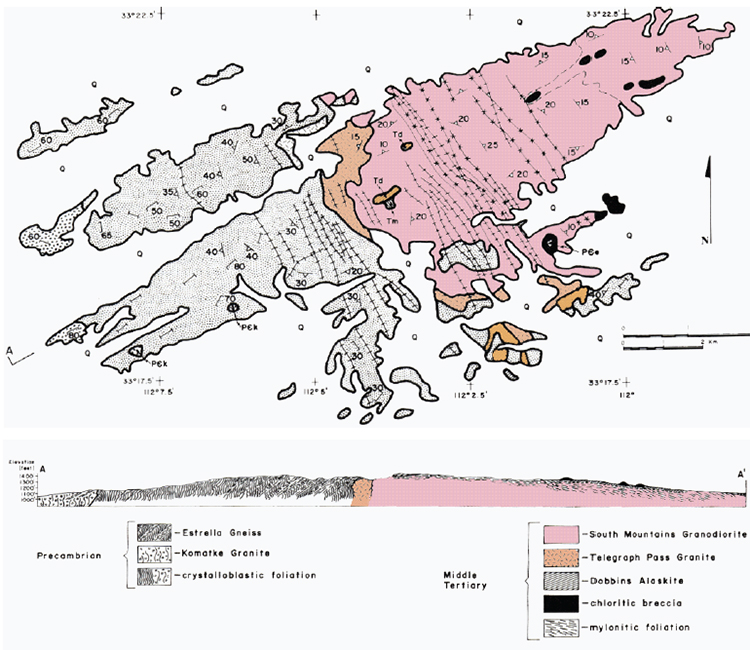 Reynolds & Johnson, 2018
Reynolds & Johnson, 2018
The key things I’d like to call your attention to are:
- How simple the geology is in this range: there are essentially two rock types.
- How the mylonitic foliation in the cross-section is almost parallel with the surface in the middle of the section, but dips ever-so-gently more steeply to the right (east-northeast).
- There are scraps of breccia atop the mylonitized granite in several places. Brittle deformation, in other words.
Steve Reynolds interprets the structural geology of the range as representing an episode of crustal extension, with deep, warm rocks experiencing mylonitization at first, then rising toward the surface and progressively colder conditions.
 Reynolds & Johnson, 2018
Reynolds & Johnson, 2018
When rocks are cold and shallow (under low confining pressures), they break rather than flow, and so in the South Mountains, we’d expect to see brittle structures (which came later) overprinting or cross-cutting ductile mylonitic foliation and lineation (which developed earlier). The overall consequence on the large scale is tectonic extension: note how the cross-sections in this trio of block diagrams get wider from earlier to younger.
So now, with that set-up, it’s finally time for some photographs of the brittle deformation that overprints the ductile… The next few photos show brittle faulting offsetting well-developed mylonitic foliation:
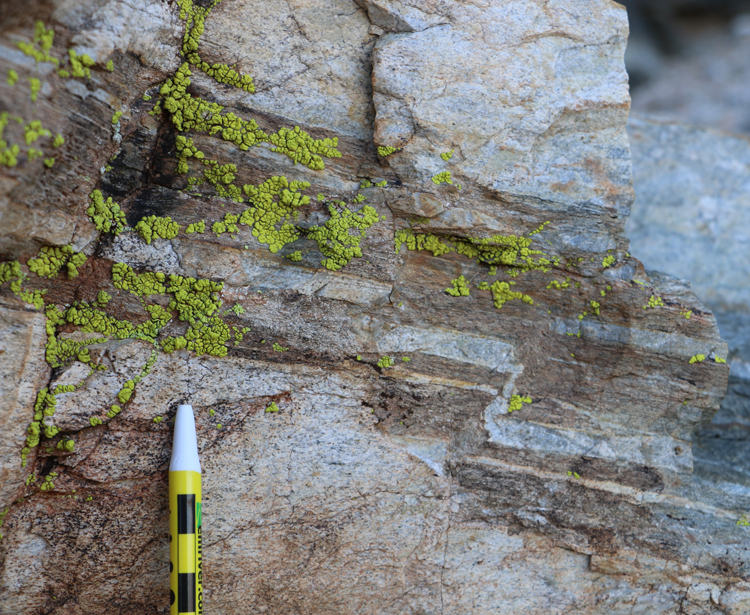
Such cute little faults!
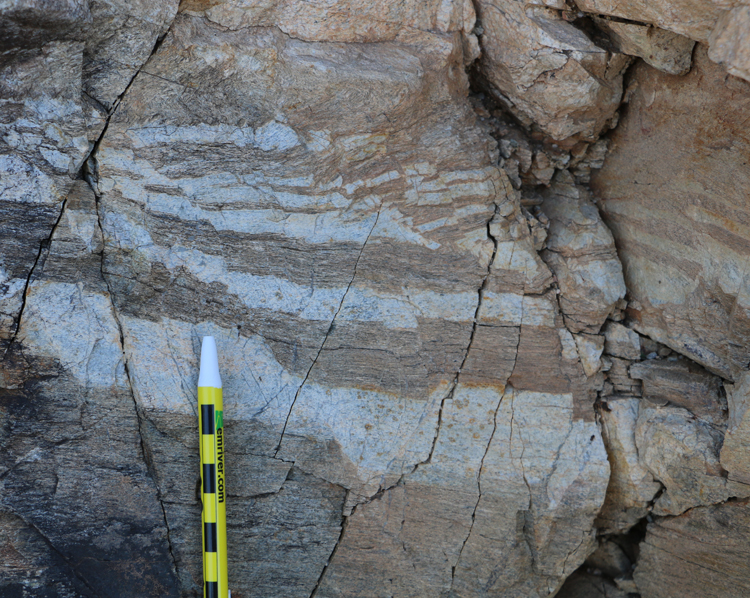
I’ve switched the orientation of the trace of foliation in the next three photos. If you look closely, you’ll see that both the light-colored rock (deformed granite) and the dark colored rock (deformed some-darker-colored-rock) are foliated:

…Zooming in closer…
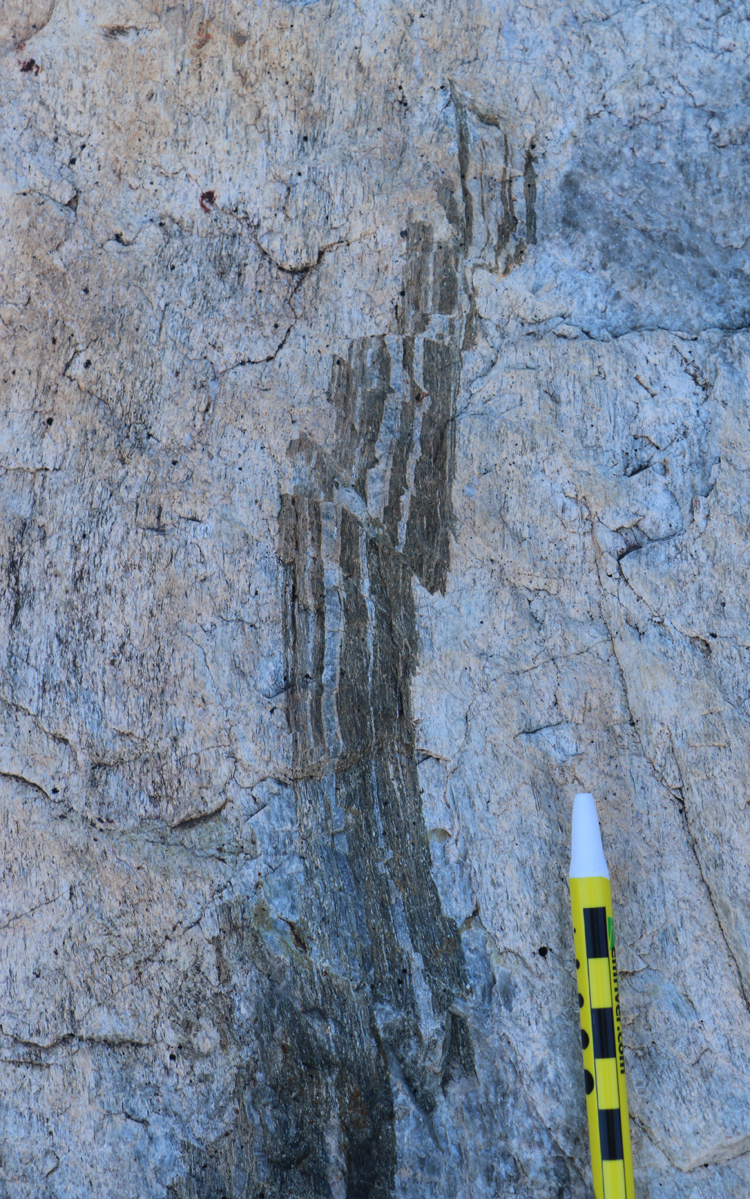
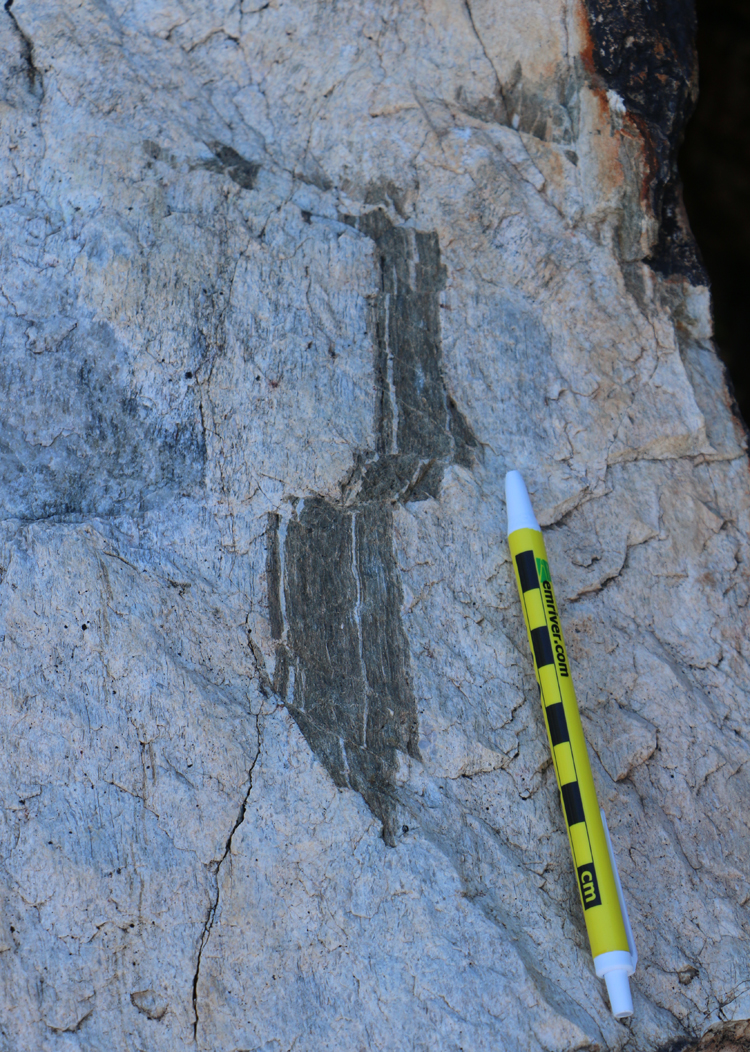
Here’s another outcrop, quite striking, especially with that foliation-perpendicular contact between foliated-dark and foliated-light so crisp and sharp:
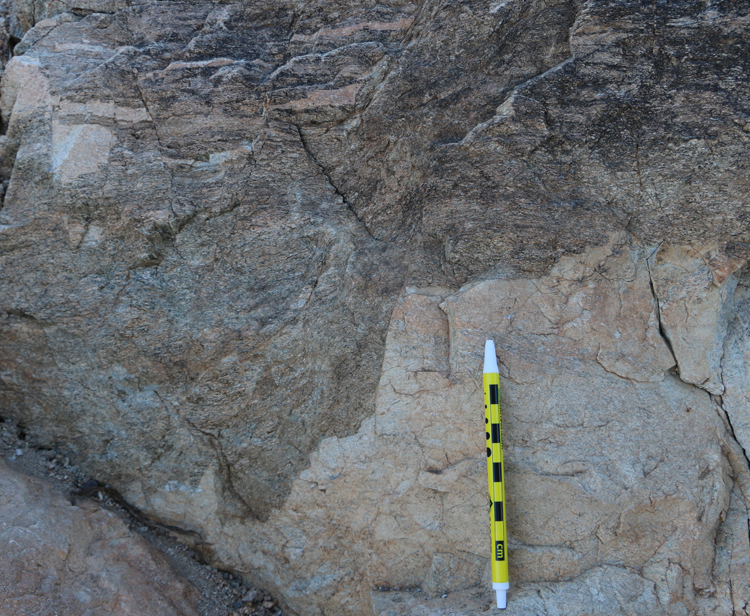
I can only imagine that contact is a fault. There are lots of little microfaults in there too, disrupting the contacting and giving it a stair step sort of morphology.
I think this was the most profound example I saw: Everything you’re looking at in this next photo is mylonite, just in two different colors, and the orientation of the trace of foliation is ~horizontal in this photo in both rock types:
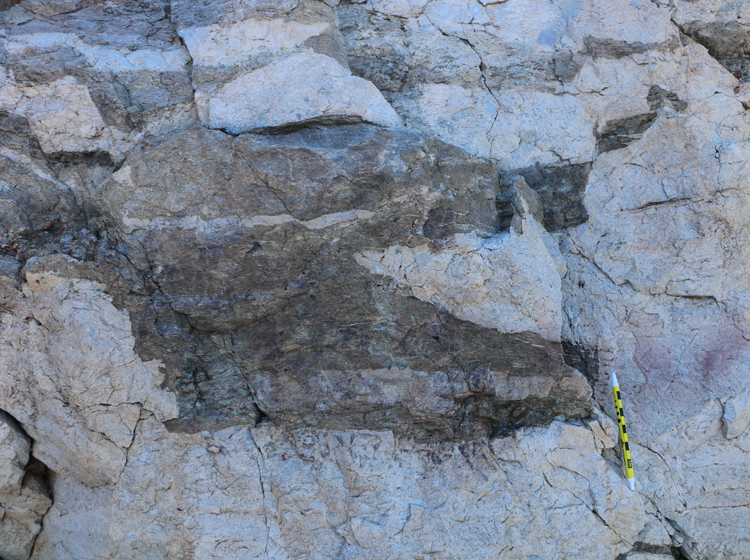
I was really struck in the field by how profoundly crisp the vertical contacts were, a clear indication there was no more subsequent mylonitization of these rocks after faulting shuffled them into the arrangement we see today. Furthermore, faulting didn’t seem to have significantly altered the orientation of the foliation (assuming it was parallel in both rock units to start with as well as after faulting had concluded), which is a little surprising.
So, annotated, I think we have to call all those light/dark foliation-perpendicular contacts faults:
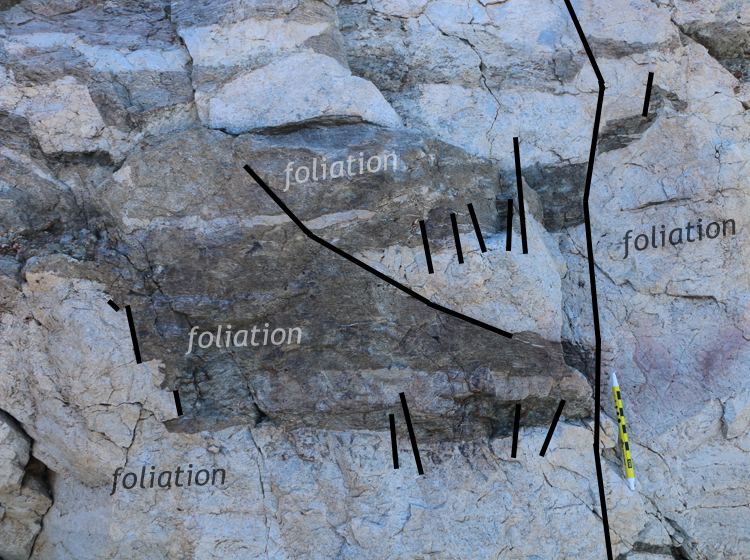
There might be some foliation-parallel slip, too. We saw that in the orientation of the pseudotachylytes I mentioned the other day. These faults, if I’m right in calling them that, are fully annealed; the modern outcrop breaks cleanly across them. They aren’t crumbly. They don’t show any cataclasis. There’s plenty of that up (structurally) above in the (map-scale) chloritic breccia.
The little train of three boudin-like fault blocks at upper right was nice, too:
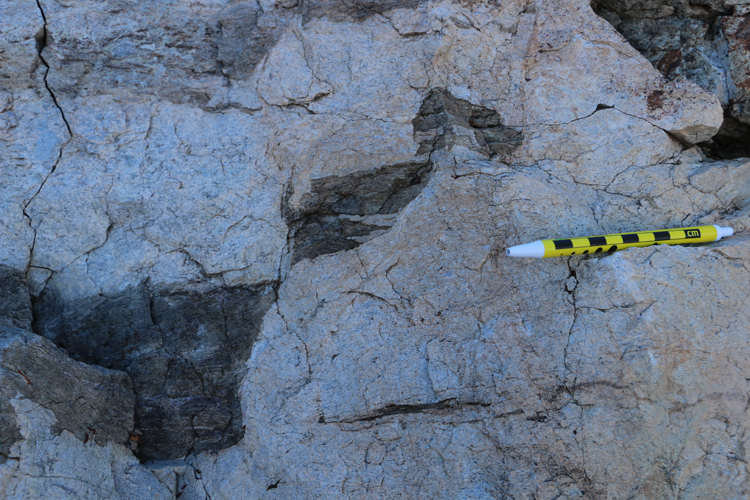
All told, these are an intriguing set of rocks and structures, and I’m glad I got the chance to explore them in more detail than when I first visited this site in January.


 Callan Bentley is Associate Professor of Geology at Piedmont Virginia Community College in Charlottesville, Virginia. He is a Fellow of the Geological Society of America. For his work on this blog, the National Association of Geoscience Teachers recognized him with the James Shea Award. He has also won the Outstanding Faculty Award from the State Council on Higher Education in Virginia, and the Biggs Award for Excellence in Geoscience Teaching from the Geoscience Education Division of the Geological Society of America. In previous years, Callan served as a contributing editor at EARTH magazine, President of the Geological Society of Washington and President the Geo2YC division of NAGT.
Callan Bentley is Associate Professor of Geology at Piedmont Virginia Community College in Charlottesville, Virginia. He is a Fellow of the Geological Society of America. For his work on this blog, the National Association of Geoscience Teachers recognized him with the James Shea Award. He has also won the Outstanding Faculty Award from the State Council on Higher Education in Virginia, and the Biggs Award for Excellence in Geoscience Teaching from the Geoscience Education Division of the Geological Society of America. In previous years, Callan served as a contributing editor at EARTH magazine, President of the Geological Society of Washington and President the Geo2YC division of NAGT.